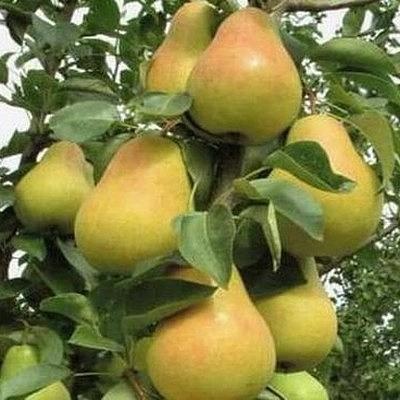
- Name synonyms: Pýrus Sapfira
- Fruit weight, g: from 50-70 to 350
- Ripening terms: autumn
- Fruit picking time: in the beginning of September
- Appointment: fresh, making stewed fruit, making jam, making dried fruits
- Growth type: dwarf
- Columnar : Yes
- Yield: high
- Height, m: up to 2
- Fruit shape: classic, pear-shaped
When choosing fruit trees for a summer cottage or a small garden, summer residents prefer compact species that give an excellent harvest. These include the columnar pear tree with the magical name of Sapphire.
Breeding history
Sapphire's autumn pear look has a long history. The Sapphire tree-column was brought out by domestic breeders in the 60s of the last century. It is this pear species that has become the standard of columnar varieties with abundant yields and simple agricultural technology. The most productive culture, growing in the southern regions of the country. When growing a pear in the northern part, where in winter the temperature drops to -25 degrees, you should not forget about the insulation of the tree.
Description of the variety
Sapphire is a dwarf tree, the height of which does not exceed 2 meters. The tree has practically no skeletal branches, since large green leaves and fruits are formed on the main trunk. Shoots with fruit buds are located at an acute angle to the central trunk. The root system of the tree is superficial. During the flowering period (from May 1 to May 15), the tree takes on a decorative appearance, covered with large white umbrella-type flowers that emit an incredible aroma. The life span of a dwarf pear culture is 11-15 years.
The fruit crop is characterized by good transportability and long-term keeping quality - up to 2-3 months. The purpose of the pear is universal, therefore it is widely used in cooking, eaten fresh, canned and processed.
Fruit characteristics
Sapphire pear is a large-fruited class. On average, the weight of the fruit is 50-70 g, but under favorable conditions, the pear gains weight up to 350 grams. The shape of the fruit is classic - pear-shaped, and the color is green-yellow with a pink-red side on the sunny side. The rind of the fruit is quite dense, waxy, but not tough. A feature of the variety is the heterogeneity of fruits by weight, that is, giant fruits weighing 350 g and mini-pears - 50 g can grow on one tree.
Taste qualities
The fruit has excellent taste and presentation. The creamy pulp of the pear has a delicate, medium-dense texture, with good oiliness and juiciness. The taste is quite balanced - sweet and sour, complemented by a pronounced dessert aroma.
Ripening and fruiting
The pear species belongs to the autumn varieties. The tree begins to bear fruit in the 3rd year after planting. Fruits are ripening from the last week of August, and you can remove the fruits in early September. Consumer maturity occurs 2 weeks after harvest.

Yield
The yield of the variety is moderate. Subject to all the recommendations for the care of the season, one bonsai can produce 15-20 kg of fragrant pears. The maximum yield is reached at 6-7 years of life of the tree, gradually decreasing by the ninth year.
Growing regions
It is recommended to grow a fruit tree in the southern and central parts of Russia. In addition, the variety has gained popularity in Ukraine and Belarus.
Self-fertility and the need for pollinators
The Sapphire Pear is endowed with self-fertility, so donor trees cannot be done without. The best pollinating varieties are: Lyubimitsa Yakovleva, Skazochnaya, Medovaya, Chizhevskaya.
Landing
Planting is carried out in the spring (after the second half of April) or in the fall (second decade of October). It is necessary to plant trees according to a certain scheme: 50x100 cm, which will provide the seedling with access to the sun and oxygen. Experienced summer residents recommend planting trees in one row, which will increase the yield.


Growing and care
The area for the pear should be chosen dry, well-lit by the sun. Neutral and slightly acidic fertile soils are considered optimal. If the soil is not fertile enough, then top dressing is preliminarily introduced. In addition, the area must be protected from drafts.
Tree care consists of: regular watering (2 times a month), top dressing according to a 5-step scheme, mulching of the near-stem zone, protection from insects and viruses. In addition, you need to periodically carry out sanitary pruning, pinch the side shoots, and also perform the autumn whitewashing of the trunk. In regions with cold winters, you will need to wrap the trunk and insulate the root system.



Disease and pest resistance
The pear has good resistance to the main diseases of pome crops - scab, fire blight, powdery mildew. Of the pests, the most dangerous are: green aphids, pear gall midge, leaf weevil and moth, which will help to get rid of treatment with special preparations - insecticides and acaricides.

Like any other fruit trees, the pear needs protection from various diseases and pests. When planting a pear on your site, you need to know in advance what diseases you should beware of. To successfully carry out the struggle, it is necessary first to correctly identify the cause of the problem. It is important to distinguish signs of disease from manifestations of the presence of insects, mites, caterpillars and other types of pests.
Resistance to soil and climatic conditions
Stress resistance of the variety is average.The tree easily tolerates light frosts, short heat and sudden temperature jumps. The pear does not like drafts, excessive dampness and prolonged drought.





































































